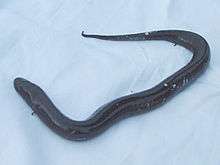Amphiuma
| Amphiuma Temporal range: Pleistocene–present | |
|---|---|
 | |
| Two-toed amphiuma | |
| Scientific classification | |
| Kingdom: | Animalia |
| Phylum: | Chordata |
| Class: | Amphibia |
| Subclass: | Lissamphibia |
| Order: | Caudata |
| Suborder: | Salamandroidea |
| Family: | Amphiumidae Gray, 1825 [1] |
| Genus: | Amphiuma Garden, 1821 |
| Species | |
Amphiuma is a genus of aquatic salamanders, the only extant genus within the family Amphiumidae /æmfᵻˈjuːmᵻdiː/. They are also known to fishermen as "conger eels" or "Congo snakes", which are zoologically incorrect designations, what with amphiumas being salamanders, and not reptiles, nor fish. Amphiuma exhibits one of the largest compliments of DNA in the living world, around 25 times more than a human.[2]
Description
Amphiumas have an elongated body, generally grey-black in color. They do have legs, but they are merely vestigial and very small. While amphiumas can be up to 116 cm (46 in) long, their legs measure only up to about 2 cm (0.79 in). It is because of this that they are often mistaken for eels or snakes. They also lack eyelids and a tongue.[3] Amphiumas also have a lateral line visible on the sides of their bodies, which are capable of detecting movement and are used in aid of hunting.[4]
Female amphiumas lay their eggs in wet mud, and then remain coiled around them for about five months, until they hatch. The larvae have external gills, but after about four months these external gills disappear and the lungs begin to work. One pair of gill slits, with fully functioning internal gills, is retained and never disappears, so the metamorphosis remains incomplete.[3]
Distribution
Amphiumas inhabit the southeastern part of the United States. They share much of the same distribution with the sirens, although they are not closely related.
In the past amphiumas have been further distributed. Fossils from the Pleistocene epoch show that they once were distributed in Europe as well.
Behavior
During the day amphiumas hide in vegetation, and at night they become active and go hunting. Their prey include frogs, snakes, fish, crustaceans, insects and even other amphiumas. Hunting and eating habits have been observed to be very similar to that of the axolotl, including the sucking in of food into their stomachs with vacuum force. If provoked they can become aggressive. They can be found in most wetlands in the coastal plain of the southeastern U.S., even ones which periodically dry, as they are able to estivate in the moist mud below drained marshland and other ephemeral wetlands. Amphiumas are rarely encountered on land, but it is possible.
Species
There are three amphiuma species, distinguished by the number of toes:
- Three-toed Amphiuma (Amphiuma tridactylum)
- Two-toed Amphiuma (Amphiuma means)
- One-toed Amphiuma (Amphiuma pholeter)
Notes
- ↑ J. Alan Holman (2006). Fossil Salamanders of North America. Life of the past. Indiana University Press. p. 107. ISBN 978-0-253-34732-9.
- ↑ "Junk DNA and the Onion Test" 1 June 2008.
- 1 2 Lanza, B., Vanni, S., & Nistri A. (1998). Cogger, H.G. & Zweifel, R.G., eds. Encyclopedia of Reptiles and Amphibians. San Diego: Academic Press. p. 72. ISBN 0-12-178560-2.
- ↑
External links
![]() Data related to Amphiuma at Wikispecies
Data related to Amphiuma at Wikispecies
